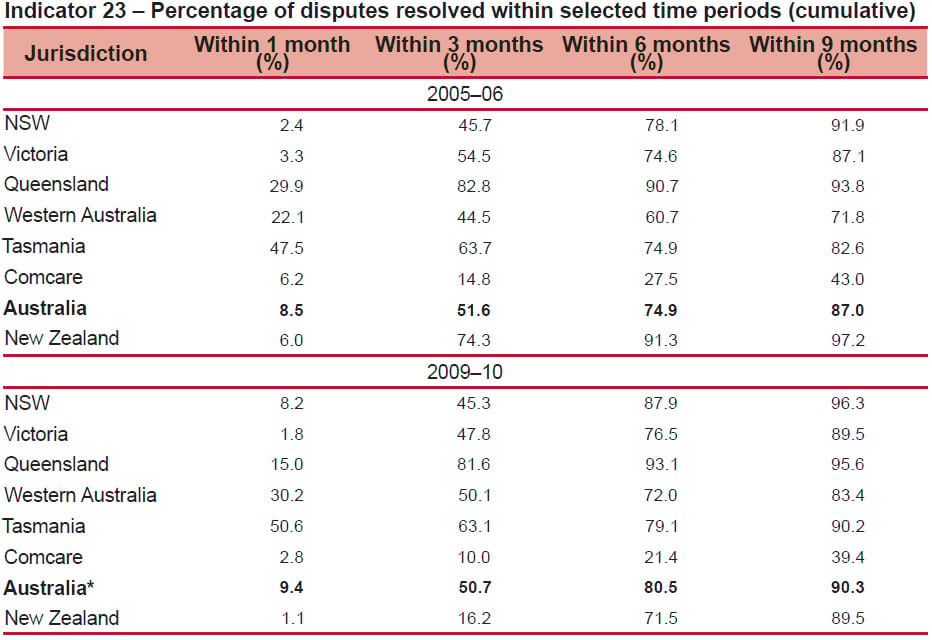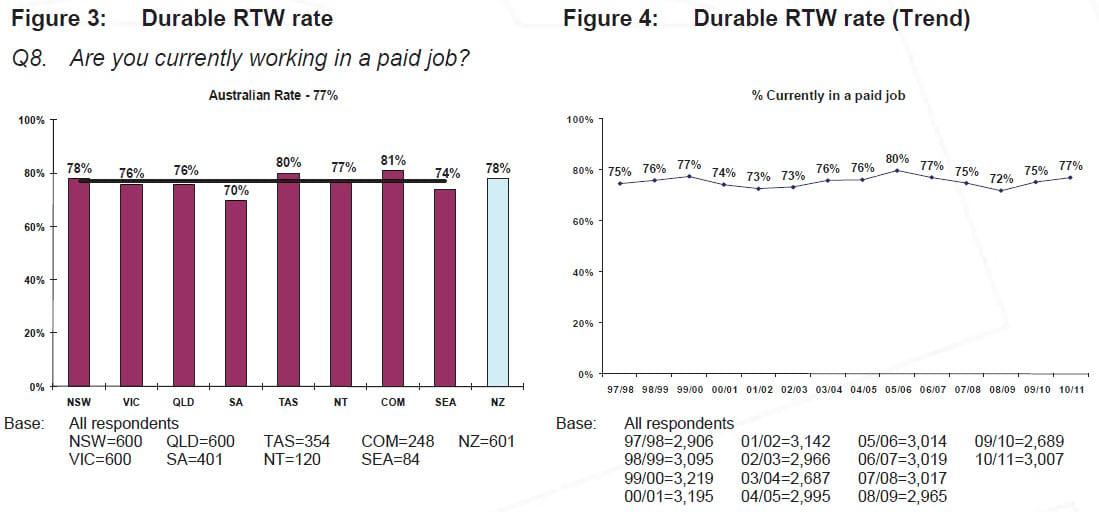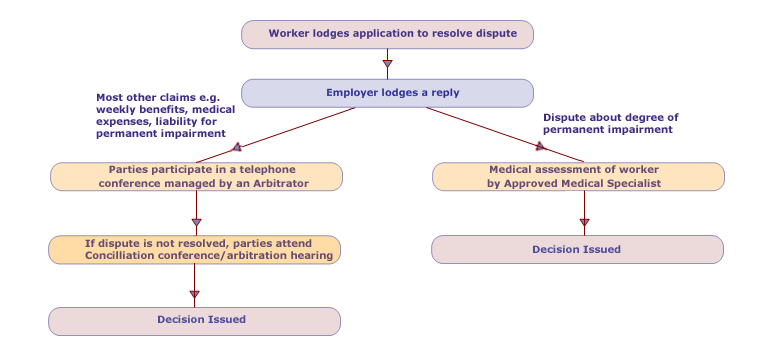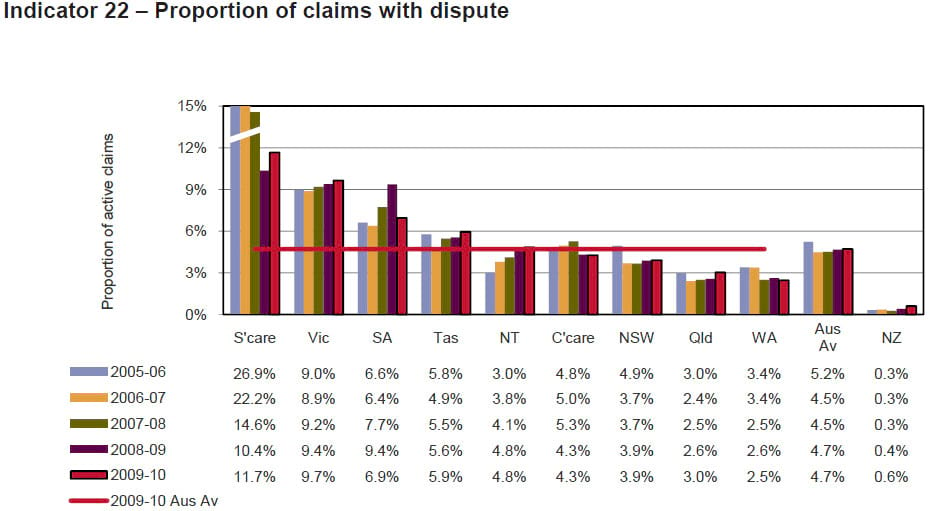Consider the alternative: Part 4 - New South Wales

In Part 4 of our series on the use of Alternative Dispute Resolution in workers’ compensation disputes we speak with Sian Leathem, Registrar of the NSW Workers Compensation Commission. New to the series? Take a look at previous articles:
- Part 1 - An introduction to ADR
- Part 2 - Interview with Nerida Wallace on Dispute Resolution systems
- Part 3 - Victoria
NSW BY THE NUMBERS
Disputation rates
Table from the 2011 Comparative Performance Monitoring Report (p. 38)
NSW's 09-10 disputation rate of 3.9% remained the same as a year ago, and remains below the national average of 4.7%.
Resolution rates

Table from the 2011 Comparative Performance Monitoring Report (p. 39)
NSW's resolution numbers paint an interesting picture. Percentage of resolutions within 1 (8.2%) and 3 (45.3%) months are lower than the national average (9.4% and 50.7%, respectively), but rates within 6 (87.9%) and 9 (96.3%) months are well above the national average (80.5% and 90.3%, respectively). Indeed, NSW boasts the highest resolution rate within 9 months of any State in Australia.
The Comparative Performance Monitoring Report warns us to treat all numbers with ‘caution’ owing to the differences in scheme design (ie what decisions can be appealed, dispute resolution models, complexity of disputes being dealt with). NSW proves the usefulness of that caution. According to the report, "the resolution times for NSW are affected by the incorporation of a mandatory medical assessment into the Workers' Compensation Commission's proceedings in relation to disputes over permanent impairment entitlements" (the subject of over 70% of all disputes lodged). This explains NSW's lower 1 and 3 month numbers.
Durable Return To Work

Table from Australia & New Zealand Return to work Monitor 2010/11 (p. 2)
According to the Heads of Compensation Authorities RTW Monitor, New South Wales had a 78% durable return to work rate throughout 2010/11.This is marginally above the national average of 77%, an average which has improved for the second year in a row after three successive years of decline..
THE NSW WORKERS’ COMPENSATION COMMISSION MODEL

Chart from the NSW Workers Compensation Commission website - 'How the process works'
According to Ms Leathem the WCC “has developed a unique dispute resolution model that incorporates a blend of conciliation and arbitration”. The stages of resolution are as follows:
- Mandatory teleconference
- Conciliation conference
- Arbitration
“The model is unique as the same person conciliates and then, if necessary, arbitrates the disputes”, Ms Leathem said. This is an important aspect of the NSW model, allowing the ‘resolver’ to develop a detailed knowledge of the issues (increasing efficiency) and allows the parties to become familiar with the person that is overseeing their dispute.
How the process proceeds depends on the nature of the dispute:
- Where the fact of an injury or ‘impairment’ is acknowledged by both parties, an independent medical specialist (experienced, independent medical professional) carries out a medical assessment of the worker. They will issue a Medical Assessment Certificate containing their findings, which will be binding on the parties.
- Where claims are made for benefits, compensation, expenses, or where liability is disputed, the matter is referred to an arbitrator, and goes through the resolution process.
Teleconference
A telephone call involving including the following parties takes place:
- The arbitrator
- The worker and their representative
- The employer, the insurer and the insurer’s legal representative
The arbitrator moderates an informal discussion about the matter with an aim of settling the matter without the parties having the meet face-to-face. The arbitrator will discuss things like:
- What facts are agreed upon and which are in dispute;
- Legal issues that must be resolved and what will be required to resolve them; and
- Any developments in the case that are not reflected in the documents
Determination ‘on the papers’
If the teleconference fails to produce a resolution, and the Arbitrator believes they have all the material they require to make a decision without bringing the parties into the same room, he or she can determine the matter ‘on the papers’ (on the basis of the documents they possess).
Conciliation Conference
Both parties (and the other parties who need to be there) meet in a conference room where the arbitrator attempts to help the parties reach agreement.
The arbitrator attempts to facilitate a negotiated agreement by, among other things:
- Facilitating discussion of the issues by each party; and
- Identifying the relative strengths and weaknesses of each party’s case, their best and worst case scenarios, and their prospect of success in arbitration (should they fail to reach an agreement).
Arbitration
If agreement is not reached in conciliation, the parties will take a short break and then begin arbitration, which is open to the public and recorded.
The arbitrator goes over everything that has been discussed in the process so far, and gets the parties to agree on what remains in dispute.
If there is no further evidence to be heard, the arbitrator will make a final and binding decision on the parties. The arbitrator can deliver his decision on the spot, but will usually send parties a ‘Certificate of Determination’ and a Statement of Reasons for the decision at a later date.
WHAT’S WORKING WELL FOR EMPLOYERS AND EMPLOYEES
Efficient and effective outcomes
According to Ms Leathem “a successful dispute resolution model encourages settlement, is timely and has durable determinations”. She says the WCC “has proven to be a successful model” by pointing to the following:
- “around 80 per cent of applications lodged in the Commission are either settled between the parties or discontinued”;
- “44 per cent of all Applications to Resolve a Dispute in this period are finalised in three months or less”; and
- “there was a judicial review rate of fewer than one per cent of all decisions made in 2010”.
Effective engagement of medical professionals
In Part 2 of this series, Nerida Wallace spoke of the impact that medical disputation and “duelling experts” can have on the efficiency of dispute resolution. According to Ms Leathem a “key feature” of the WCC system is “the streaming of medical disputes to Approved Medical Specialists”.
These specialists are called upon to “provide an independent medical assessment relating to a workplace injury”.
HOW THEY ARE MAKING IT BETTER
Recent changes to the WCC have aimed to increase the quality and efficiency of outcomes.
Shift toward full-time Arbitrators
The WCC has shifted away from a large number of sessional Arbitrators to a group of “three full-time Senior Arbitrators, thirteen full-time Arbitrators and a further four part-time Arbitrators.” According to Ms Leathem, the change was made for three reasons:
- “More consistent practices”;
- “Increased opportunities for professional development, support and peer communication”; and
- “To enhance the quality and durability of decisions”.
Arbitrator Practice Manual
The development of a one-stop information source for Arbitrators was introduced to “assist in first-instance decision-making and to reduce the number of appeals”. According to Ms Leathem, it was intended to provide guidance on:
- procedural and ethical issues; and
- legal issues that relate to the work of the WCC.
“It is well recognized that workers’ compensation law is extremely complex”, Ms Leathem says. Providing a resource that provides up-to-date material on the matters coming before the Commission not only improves efficiency (by “greatly reducing research time”), but equips Arbitrators with the information they need to make the right decision the first time.
Arbitrator Professional Development Program
The introduction of the WCC Arbitrators’ Professional Development Program aims to monitor performance standards as well as provide opportunities for development.
Under the program, Arbitrators are exposed to a variety of professional development opportunities, in addition to mentoring and peer review.
A ‘framework of competencies’ is used to gauge how Arbitrators are performing, provide acknowledgement for those performing at or above the standards expected, and allow those who can improve the feedback they need to be able to do so. This allows for a “robust and transparent program for the appraisal of Arbitrator competency.”
OVERALL MONITORING OF SCHEME PERFORMANCE
“WorkCover NSW monitors the performance of the broader NSW workers compensation scheme.” As part of that process, WorkCover publishes the ‘Scheme Agent Performance Report’ twice a year, which outlines the performance of the seven Scheme agents in the areas of ‘Claims Management and Return to Work’ and ‘Service and Processing’.
WHAT THEY ARE LOOKING TO IMPROVE
Insurers have a large role to play in how smoothly a process plays out. Ms Leathem acknowledges this, pointing out that “[t]he system can be improved by greater involvement by insurers in matters coming before the Commission”. She adds, “the Workers Compensation Commission is working with WorkCover and others to better educate insurers in their role.”
THE BOTTOM LINE
In concluding her thoughts on how ADR is helping employees and employers achieve better outcomes, Ms Leathem says “the early resolution of disputes using ADR techniques ensures that a high percentage of claims can be settled more quickly and more cost effectively than would otherwise occur”. With twice yearly monitoring and a series of reforms aimed at providing dedicated, well resourced and constantly educated Arbitrators, the WCC appears well positioned to enhance the effectiveness of ADR in NSW workers' compensation disputes.
Sian Leathem is the Registrar of the NSW Workers Compensation Commission


